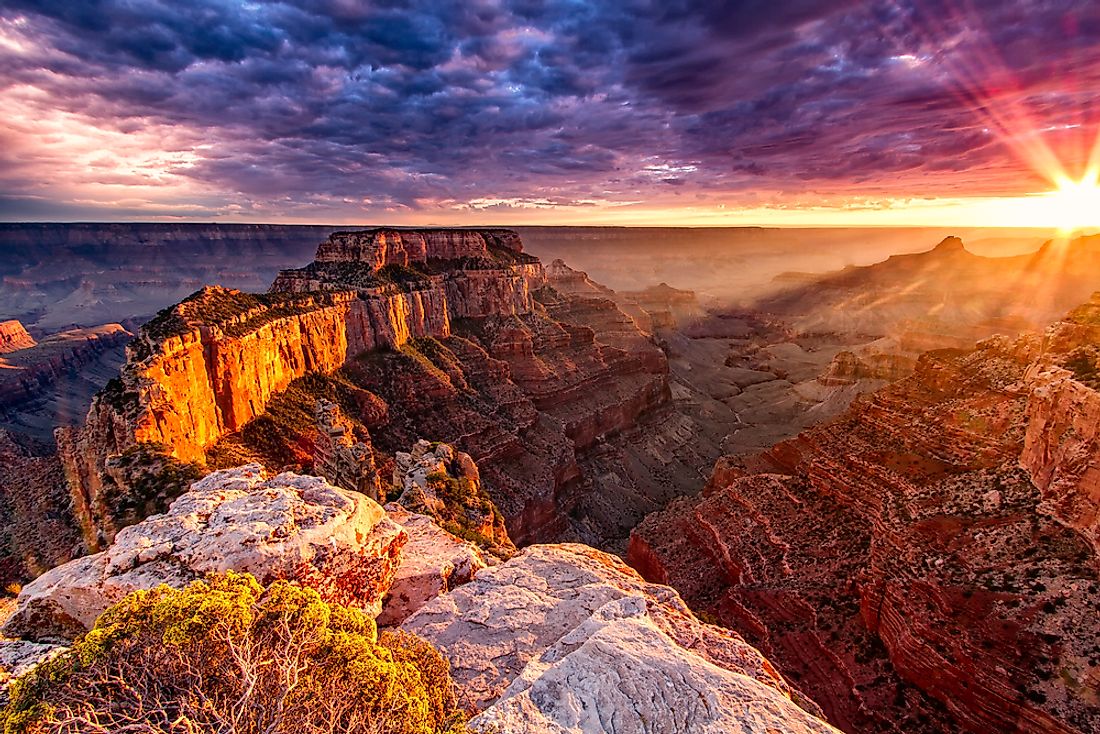What Is A Canyon?

When a river cuts through resistant rocks to form a steep-walled, deep V-shaped valley, it results in the formation of a canyon. Canyons usually occur in a river’s upper course where the river has a powerful and swift current that allows the river to dig deep into the valley floor.
How and Where Do Canyons Form?
The erosion of plateaus or mountains formed by a river cutting through the rocks over geologic timescales results in the formation of a canyon. Rivers have a natural tendency to erode the surfaces lying underneath its water level to allow for a smoother flow of water. Usually, the river keeps cutting through the underlying rock till the river reaches a baseline elevation which is the same elevation as the water body into which the river drains.
The wind and water from rivers erode away the less resistant rocks like shale from the river bed and banks. Frost wedging in rivers forming canyons at higher altitudes also assist the erosion process. Here water enters the cracks and crevices of rocks and freezes during periods of low temperature. The ice crystals formed between rocks pushes the rocks apart and results in chunks of rocks breaking down. The harder rock strata that are usually made of granite or sandstone forms the walls of the canyon as it is resistant to weathering processes.
Canyons are common in areas of limestone rock as limestone is soluble (easily dissolved) to a certain extent. Thus, the branches of a river initially carve out a cave system in the limestone bed. Eventually, the cave walls and ceilings collapse resulting in the formation of a canyon.
What Does the Word “Canyon” Mean?
Canyon is a word of Spanish origin with the same meaning. The term “canyon” is generally used in North America while the term “gorge” and “ravine” are more popular in Europe and Oceania. In Canada, ravine refers to more wooded and open valley while a gorge refers to a narrower landform. In the United States, the term canyon is more popular in the southwest of the country and gorge in the northwest.
Types of Canyons
Mountain-type Canyon: Mountain-type canyons result when rivers carve out splits between mountains. The Provo Canyon in Utah is an example of a mountain-type canyon.
Box Canyon: Canyons that have an opening on only one end are called the box canyons.
Slot Canyon: These are narrow canyons with smooth walls.
Submarine Canyon: Steep-sided valleys in the continental slope’s seabed are known as submarine canyons. Underwater landslides and turbidity currents usually trigger the formation of such canyons.
The World's Most Notable Canyons
The Grand Canyon (Arizona, USA): is one of the largest canyons in the world and is an extremely popular destination for tourists visiting the US from all parts of the world. The Grand Canyon is on an average 1,600 meters deep and has a volume of 4.17 trillion cubic meters. It is one of the Seven Natural Wonders of the World.
The Yarlung Tsangpo Gorge (Tibet, China): the Guinness Book of Records records the Yarlung Tsangpo Gorge as the world’s deepest canyon. The canyon is located in the Tibet Autonomous Region of China.
The Indus Gorge (Karakoram, Pakistan): the Indus Gorge is also one of the top contestants for the title of the deepest canyons in the world and is recorded by some as the actual winner of the title. The Indus Gorge is located at the confluence of the Indus and Gilgit rivers where the Karakoram Highway was constructed.
The Kali Gandaki Gorge (Nepal): by some measures, the Kali Gandaki Gorge is also regarded as the deepest canyon in the world. It is the gorge of the Gandaki River in the Himalayas of Nepal.
The Cotahuasi Canyon and Colca Canyon (Peru): these canyons are located in southern Peru and are the deepest in the Americas being over 12,000 deep.
The Copper Canyon (Chihauhau, Mexico): this canyon is longer and deeper than the Grand Canyon.
Fish River Canyon (Namibia): Africa’s largest canyon.
Greenland's Grand Canyon (Greenland): A recently discovered tentative canyon, it is located under the ice sheet in Greenland. It is possibly the largest canyon in the world.
Capertee Valley (New South Wales, Australia): Located in Australia, it is often regarded as the second widest canyon in the world.











